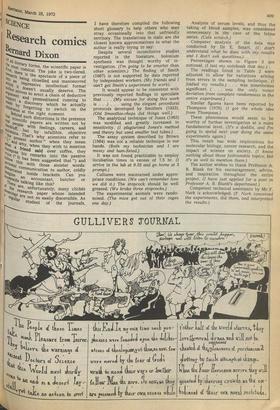, scIENcE R esearch comics
Bernard Dixon
CI all ' CI all ' ti,,, l Iterary forms, the scientific paper is i'ir" rnost comical. The joke is two-tiered. 4there is the spectacle of a piece of ItIt°earch being chiselled and manoeuvred ,4,411 irripressive intellectual format aLifls.1 it doesn't usually deserve. The ar"10r strives to erect a chain of deductive sLign4rnent and premeditated cunning to tria'di?t,_ a discovery which he actually ap,,P-°Y forgetting to switch on the aratus at the right moment. that8efUnd such distortions is the pretence real scientific papers are written not by cia People with feelings, careers, and ) autlir,d_ruff, but by infallible, objective "th-4ata. That's why scientists refer to Present author" when they mean Ivhaiarld why, when they wish to mention tra a friend said over coffee, they voinsPose his remarks into the passive fonee (" It has been suggested that ") and PerRc),W this with those sinister wor s: der„-410-1 communication to author, coldl y illl'a areated inside brackets. Can you hougitlelv an accountant, butcher or ,,!enerA ife talking like this? i Of th are, unfortunately, many clichés_ rIlea`ge research paper whose intended a rrl„irlgs are not so easily discernible. As 'Illiar student of the journals, I have therefore compiled the following short glossary to help others who may stray occasionally into that unfriendly territory. The translations in italic are the closest known approximations to what the author is really trying to say: Despite several inconclusive studies reported in the literature, bolonium synthesis was thought worthy of investigation. (I'm going to be smarter than other scientists.) The finding of Smith (1967) is not supported by data reported by independent workers. (My friends and I can't get Smith's experiment to work). It would appear to be consistent with previously reported findings to speculate that . . . (My excuse for doing this work is . .) . . . using the elegant procedural protocols developed by Smithers (1923). (Old Smoothie-chops did things well.) The analytical technique of Jones (1963) was modified and greatly increased in sensitivity. (I plagiarised Jones's method and theory but used smaller test tubes.) The assay system described by Brown (1964) was not a reliable technique in our hands. (Both my technician and I are messy and ham-fisted.) It was not found practicable to employ incubation times in excess of 7.5 hr. (I arrive in the lab at 9.30 and go home at 5 prompt.) Cultures were maintained under appropriate conditions. (We can't remember how we did it.) The stopcock should be well greased. (We broke three stopcocks.) The experimental animals were randomised. (The mice got out of their cages one day.) Analysis of serum levels, and thus the taking of blood samples, was considered unnecessary in the case of the feline series. (Cats scratch.) Computer analysis of the data was conducted by Dr E. Smart. (I don't understand what he does with my results and I don't ask questions.) Percentages shown in Figure 3 are notional. (I lost my notebook that day.) The readings listed in Table 2 were adjusted to allow for variations arising from errors in the sampling technique. (I fiddled my results.) . . . was nonetheless significant. ( . . was the only minor deviation from complete randomness in the entire experiment.) Similar figures have been reported by Thompson (1970). (1 got the whole idea from Thompson.) These phenomena would seem to be worthy of further investigation at a more fundamental level. (It's a doddle, and I'm going to spend next year doing the same experiments again.) This result has wide implications for molecular biology, cancer research, and the impact of science on society. (I know nothing about these fashionable topics, but it's as well to mention them.) The author wishes to thank Professor A. B. Blank for his encouragement, advice, and inspiration throughout the entire project. (I have just applied for a post in Professor A. B. Blank's department.) Competent technical assistance by Mr F. Nurk is acknowledged. (F. Nurh conceived the experiments, did them, and interpreted the results.)










































 Previous page
Previous page